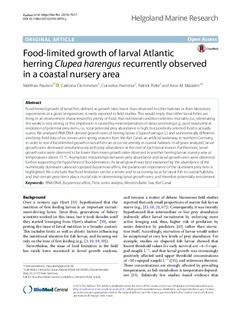| dc.description.abstract | Food-limited growth of larval fish, defined as growth rates lower than observed in other habitats or from laboratory experiments at a given temperature, is rarely reported in field studies. This would imply that either larval fishes are living in an environment characterized by plenty of food, that nutritional condition selective mortality (i.e., eliminating the weak) is very strong, or this impression is caused by misinterpretation of data concerning e.g., poor taxonomical resolution of potential prey items, i.e., total potential prey abundance is high, but positively selected food is actually scarce. We analyzed RNA:DNA derived growth rates of herring larvae (Clupea harengus L.) and taxonomically differentiated prey field data of six consecutive spring seasons from the Kiel Canal, an artificial waterway in northern Germany, in order to test if food-limited growth in larval fish can occur recurrently in coastal habitats. In all years analyzed, larval growth rates decreased simultaneously with prey abundance at the end of each larval season. Furthermore, larval growth rates were observed to be lower than mean growth rates observed in another herring larvae nursery area at temperatures above 15 °C. Asymptotic relationships between prey abundance and larval growth rates were observed, further supporting the hypothesis of food-limitation. As larval growth was best explained by the abundance of the numerically dominant calanoid copepod Eurytemora affinis, the paramount importance of the dominant prey item is highlighted. We conclude that food limitation can be a severe and re-occurring issue for larval fish in coastal habitats, and that certain prey items play a crucial role in determining larval growth rates, and therefore potentially recruitment. | nb_NO |

